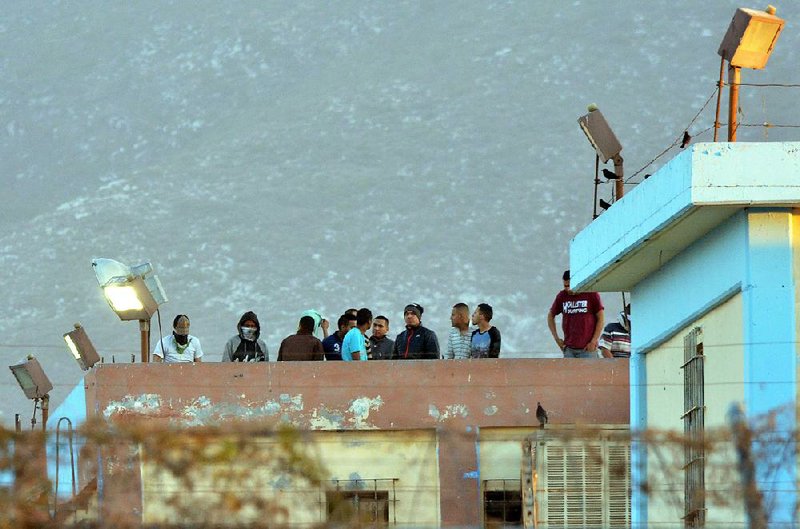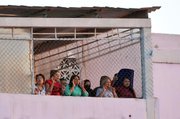MONTERREY, Mexico -- Mexico's deadliest prison brawl in many years was a bloodbath in which inmates attacked one another with hammers, cudgels and makeshift blades, authorities said, underlining yet again the power that drug cartels wield inside many of the country's lockups.
Questions about the melee deepened Friday when Roberto Flores, prosecutor of the northern state of Nuevo Leon, revealed that three officers of the state public safety department, which supplies the prison's guards, had been charged with homicide and abuse of authority. He did not say if they were accused of killing inmates, but authorities have said a guard fired a bullet that was found in one of the inmates killed.
Flores also said that four of the nine bodies still unidentified could not be named because the prison had no record of them at the facility.
"It is a pretty irregular situation," he said. The other five bodies were badly burned and await DNA testing.
Jaime Rodriguez, governor of Nuevo Leon, said 60 hammers, 86 knives and 120 shivs were used in the previous day's fighting at the Topo Chico prison in Monterrey, where 49 inmates were hacked, beaten or burned to death, and a dozen more injured.
At least 40 of the victims "died from wounds from stabbing and cutting weapons, blows from hammers and clubs," Rodriguez said at a news conference.
Authorities also seized various kinds of contraband items from marijuana and cocaine to televisions and USB memory sticks.
A dispute between rival factions of the Zetas cartel was believed to be behind the violence.
"What we have to see as a reality in the entire penitentiary system is that there is self-rule" by the inmates, Rodriguez said. "All this corruption inside the prison creates the conditions we have today."
He acknowledged that prisoners effectively lord over the facility and that there were not enough guards watching them: "Nobody wants to be a guard" because of the meager pay, he said.
About half the inmates at Topo Chico have been sentenced for minor offenses or are suspects still awaiting trial. Nevertheless they are housed in the prison's overcrowded general population alongside many of the country's most hardened killers.
One of them was Raymundo Gonzalez Hernandez, a 23-year-old who is accused of kidnapping but whose trial is still pending. He was not among those listed as wounded during the riot, but his cousin said he was covered by bruises and welts when she was allowed inside to see him.
"Both his eyes were practically closed from all the hits they gave him," Cynthia Hernandez said.
"He couldn't even speak, he just went like this," she added, moving her head from side to side.
The harsh conditions inside the lockup were a familiar story for Victoria Casas Gutierrez, a cleaning lady who waited for hours for news of her 21-year-old son, Santiago Garza Casas, who was facing trial on accusations that he acted as a lookout for a criminal gang.
Garza was sent to Topo Chico in September for missing a parole appointment and immediately thrown in with a prison population that included convicted murderers.
With their gang ties and access to drugs and guns, many say the Zetas and Gulf cartels run the prison.
"They charge taxes, and if the relatives don't bring a certain amount ... they beat them," Casas Gutierrez said, adding that the payments can run into the hundreds of dollars. "Sometimes we have to sell our homes."
"There is vice inside and everything that is in there is their fault, the authorities," she said.
Casas Gutierrez's son was not on the list of the dead.
No escapes were reported in the clash, which took place on the eve of Pope Francis' arrival in Mexico, a visit that is scheduled to include a trip next week to another prison in the border city of Ciudad Juarez.
The fighting began about midnight Wednesday with prisoners setting fire to a storage area, sending flames and smoke billowing into the sky.
The clash was initially said to be between two gangs led by a member of the infamous Zetas drug cartel, Juan Pedro Zaldivar Farias, also known as "Z-27," and Jorge Ivan Hernandez Cantu, who has been identified by Mexican media as a cartel figure in the regions near the Gulf of Mexico.
But National Security Commissioner Renato Sales Heredia said later that authorities believe the fight was between two factions of the Zetas for control of the prison.
Rodriguez blamed the violence on "the old, outdated, obsolete system" under which Mexican prisons are run and suggested after having visited the United States that his country may have to move to U.S.-style, privately operated prisons.
"We have to think about efforts with private initiative," he said. "We have not been doing rehabilitation work."
A Section on 02/13/2016

